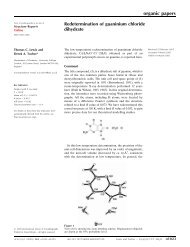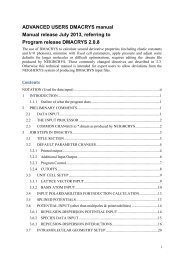An Introduction to the Theory of Crystalline Elemental Solids and ...
An Introduction to the Theory of Crystalline Elemental Solids and ...
An Introduction to the Theory of Crystalline Elemental Solids and ...
Create successful ePaper yourself
Turn your PDF publications into a flip-book with our unique Google optimized e-Paper software.
12<br />
FIG. 4: B<strong>and</strong> structure (a), density <strong>of</strong> states (DOS) (b), <strong>and</strong> partial DOS (PDOS) (c) for bulk<br />
Cu as computed from a plane-wave pseudopotential DFT calculation within <strong>the</strong> LDA. In (c) <strong>the</strong><br />
PDOS are projected on<strong>to</strong> Cu s, p, <strong>and</strong> d orbitals. The energy zero is <strong>the</strong> Fermi level (computed<br />
by <strong>the</strong> authors).<br />
We now introduce some simple models for bonding in metals <strong>and</strong> semiconduc<strong>to</strong>rs such<br />
as jellium <strong>and</strong> hydridization <strong>and</strong> at <strong>the</strong> same time assess our <strong>the</strong>oretical <strong>to</strong>ol <strong>of</strong> choice,<br />
DFT, at predicting some <strong>of</strong> <strong>the</strong> central cohesive properties <strong>of</strong> solids.<br />
4.1.1 Bonding in Metals<br />
The essential characteristic <strong>of</strong> metallic bonding is that <strong>the</strong> valence electrons are delocalized<br />
among a lattice <strong>of</strong> metal a<strong>to</strong>ms. Delocalization is <strong>the</strong> consequence <strong>of</strong> heavy overlap<br />
between <strong>the</strong> individual valence wavefunctions resulting in <strong>the</strong> valence electrons being<br />
shared by all <strong>the</strong> a<strong>to</strong>ms in <strong>the</strong> “community”. In most abstract terms, metals can thus be<br />
perceived as a<strong>to</strong>mic nuclei immersed in a featureless sea (or “glue”) <strong>of</strong> electrons. This<br />
electron sea leads <strong>to</strong> bonding that is generally not directional, resulting in close-packed<br />
crystal structures being <strong>of</strong>ten favored, such as <strong>the</strong> fcc <strong>and</strong> hcp structures. Because <strong>of</strong> <strong>the</strong><br />
strong overlap <strong>of</strong> <strong>the</strong> orbitals <strong>the</strong> resultant electronic wavefunctions or b<strong>and</strong>s <strong>of</strong> a metal<br />
will thus exhibit a strong dispersion in reciprocal space, k space. As an example we show<br />
in Fig. 4(a) <strong>the</strong> b<strong>and</strong> structure <strong>of</strong> bulk Cu.<br />
A useful quantity for interpreting <strong>the</strong> characteristics <strong>of</strong> chemical bonding, that we will<br />
use throughout <strong>to</strong> examine metals, is <strong>the</strong> density <strong>of</strong> states. It is defined as<br />
∫<br />
N(ɛ) =<br />
n(r, ɛ)dr =<br />
∞∑<br />
δ(ɛ − ɛ i ) , (23)<br />
where <strong>the</strong> sum goes over all eigenstates (orbitals) with eigenvalues, ɛ i <strong>of</strong> <strong>the</strong> Kohn-Sham<br />
Hamil<strong>to</strong>nian. Cutting through this DOS is <strong>the</strong> Fermi level (E F ): <strong>the</strong> energy below which<br />
<strong>the</strong> one-electron levels are occupied <strong>and</strong> above which <strong>the</strong>y are not, in <strong>the</strong> ground-state<br />
<strong>of</strong> a metal. Again we illustrate <strong>the</strong>se concepts with <strong>the</strong> example <strong>of</strong> Cu, displayed in<br />
Fig. 4(b). For future reference, we note that for metals at 0 K <strong>the</strong> Fermi level is equivalent<br />
<strong>to</strong> <strong>the</strong> chemical potential <strong>of</strong> <strong>the</strong> electrons.<br />
<strong>An</strong>o<strong>the</strong>r useful quantity, which is not readily accessible in any simple manner from experiment,<br />
is <strong>the</strong> state-resolved DOS, also called <strong>the</strong> projected DOS (PDOS):<br />
i=1







